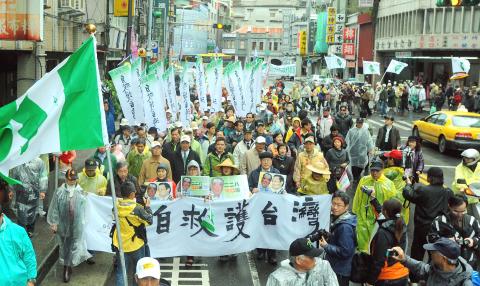|
Hundreds commemorate
228 victims
OUTRAGE: Families of the victims and rights
activists condemned Hau Pei-tsun for questioning the number of people who died
in the massacre
By Chris Wang and Lee Hsin-fang / Staff Reporters

Members of the Taiwan Nation
Alliance and Taiwan 228 Care Association march through Taipei’s Datong District
to commemorate the 228 Massacre, which was sparked by an altercation between
government tobacco agents and a woman selling contraband cigarettes in the area
on Feb. 27, 1947.
Photo: Wang Yi-sung, Taipei Times

A woman wipes away tears after
placing lilies on a monument during a memorial for the 65th anniversary of the
228 Incident in Taipei yesterday.
Photo: Pichi Chuang, Reuters
Hundreds of people marched in the streets
of Taipei yesterday in memory of those who perished in the wake of the 228
Incident 65 years ago.
Representatives from various civic groups and victims’ families joined the
parade, which began at Yongle Market, to commemorate victims of the bloody
suppression of anti-government uprisings that began on Feb. 27, 1947, resulting
in the deaths of tens of thousands of civilians, including many Taiwanese
leaders and intellectuals.
Among the crowd was 80-year-old Lee Rong-chang (李榮昌), a wheelchair-bound son of
a victim of the 228 Massacre, who insisted on joining the march despite the cold
and the rain.
Lee recalled the afternoon on March 10, 1947 — the day his father went missing.
“While my mother was cooking squid rice porridge in the afternoon for family
guests, several military police and plainclothes officers showed up,” Lee said.
After the uninvited visitors told his father that his presence was “requested by
a superior,” his father was taken away and never returned home.
“We looked for my father for more than half a year, but still had no clue about
his whereabouts,” Lee said, “so we reported him as a missing person.”
Because any individual who made any reference to the massacre was deemed a
communist or a pro-independence advocate at the time, Lee said he was afraid to
talk about how his father was taken away during the White Terror period.
Lee condemned former premier Hau Pei-tsun’s (郝柏村) comment in an op-ed piece on
Tuesday last week, in which he said no more than 1,000 people were killed in the
massacre.
Hau was attempting to erase people’s memories of the brutal massacre, Lee said.
At the Dadaocheng Wharf (大稻埕碼頭), where the march ended, Taiwan 228 Care
Association chairman Chang Yen-hsien (張炎憲) told the crowd that the only way to
prevent the brutal oppression from recurring was to keep Chinese influence from
entering Taiwan.
“It is ironic that, 65 years ago, the KMT [Chinese Nationalist Party] accused
those who were arrested and killed [in the massacre] of being incited by the
Chinese Communist Party [CCP], and now it is collaborating with the CCP to
coerce Taiwanese,” he said.
Chang said all available research showed that Hau’s estimate of the number of
dead was inaccurate, adding that President Ma Ying-jeou (馬英九) has not offered a
sincere apology over the Incident and that his appearances at the annual
memorials were only “ceremonial.”
Other speakers also accused Hau of “distorting history” and warned of growing
Chinese influence in Taiwan, with Taiwan Solidarity Union Chairman Huang Kun-huei
(黃昆輝) saying the commemoration of the massacre was even more meaningful 65 years
later under Ma’s pro-Beijing administration.
Taiwanese should not harbor false expectations about China as their predecessors
did toward their “motherland” after the World War II era, Huang said.
Participants concluded the memorial march by releasing water lanterns to pay
tribute to the dead.
Commemorative ceremonies were also held in other cities, including New Taipei
City (新北市), Greater Tainan and Greater Kaohsiung.
Greater Tainan Mayor William Lai (賴清德) urged Ma to offer a clear explanation of
the massacre, while Greater Kaohsiung Mayor Chen Chu (陳菊) called on Ma to “pay
attention to the hate speech of KMT members to prevent Taiwan’s society from
deeper division.”
Translated by Stacy Hsu, Staff writer
|
![]()
![]()
![]()